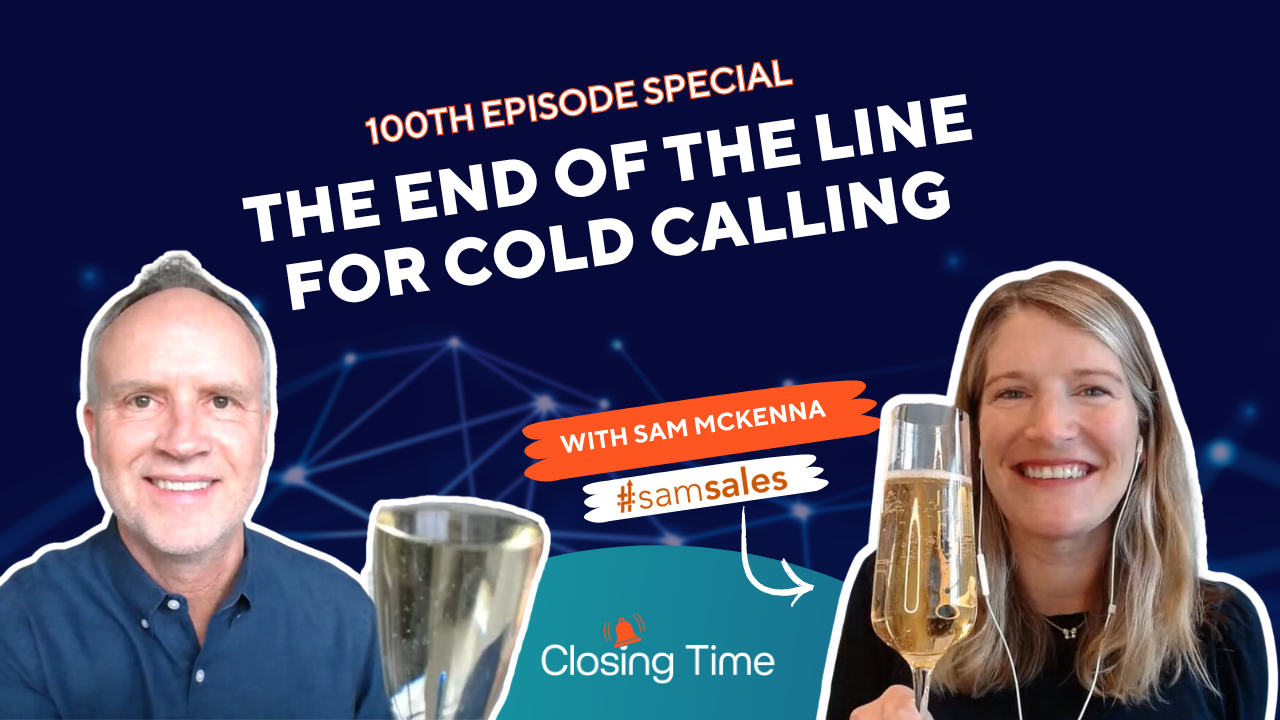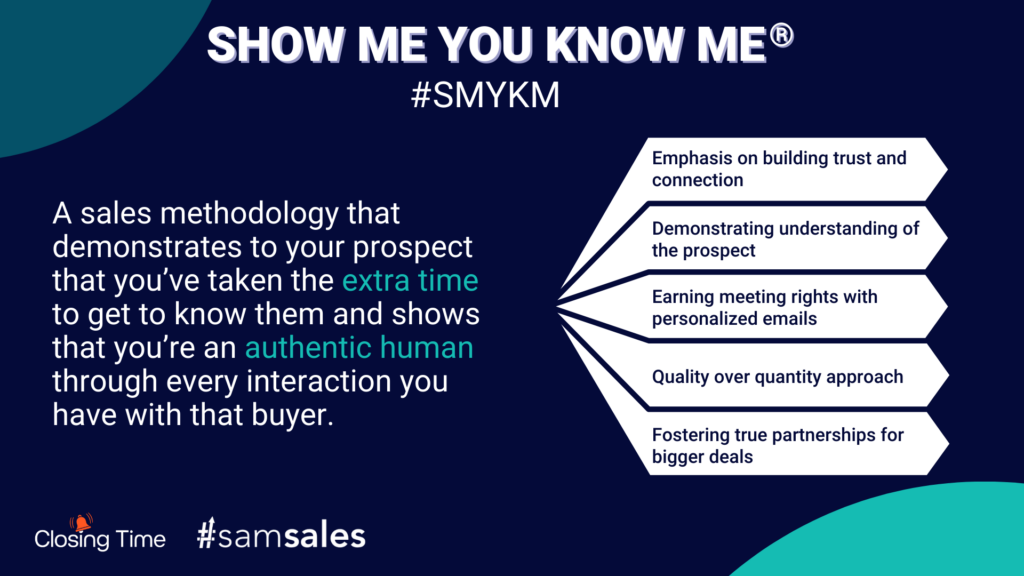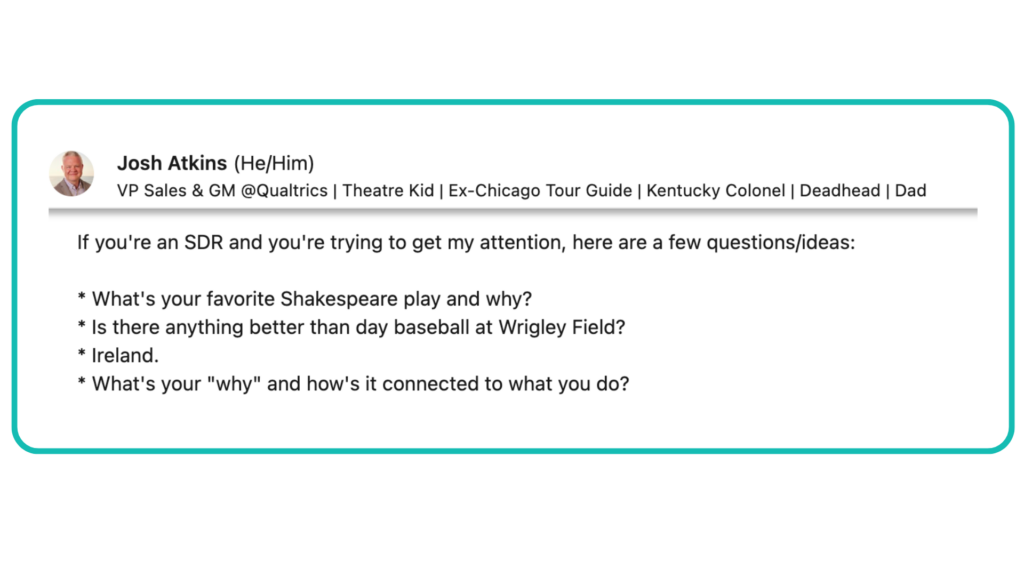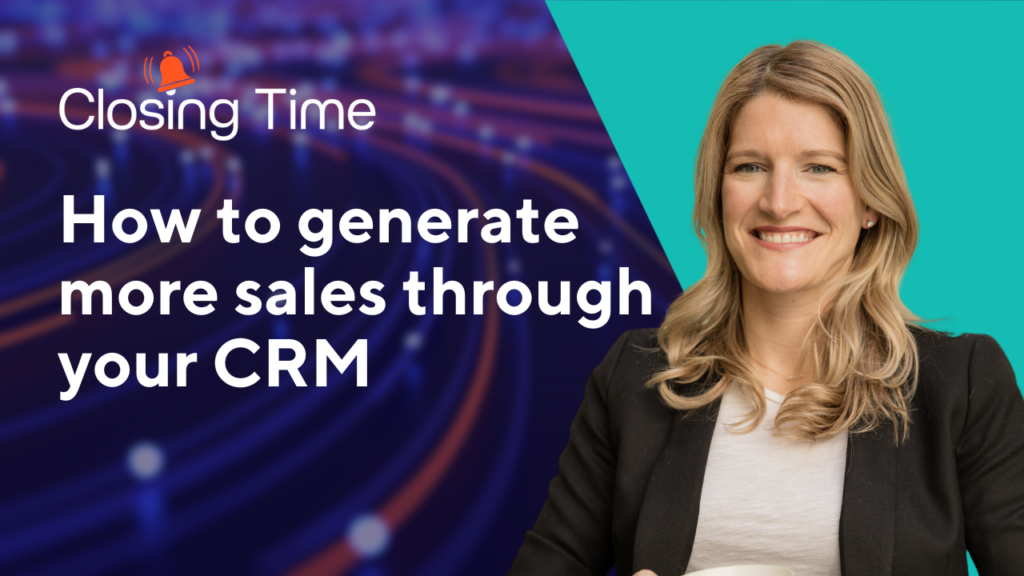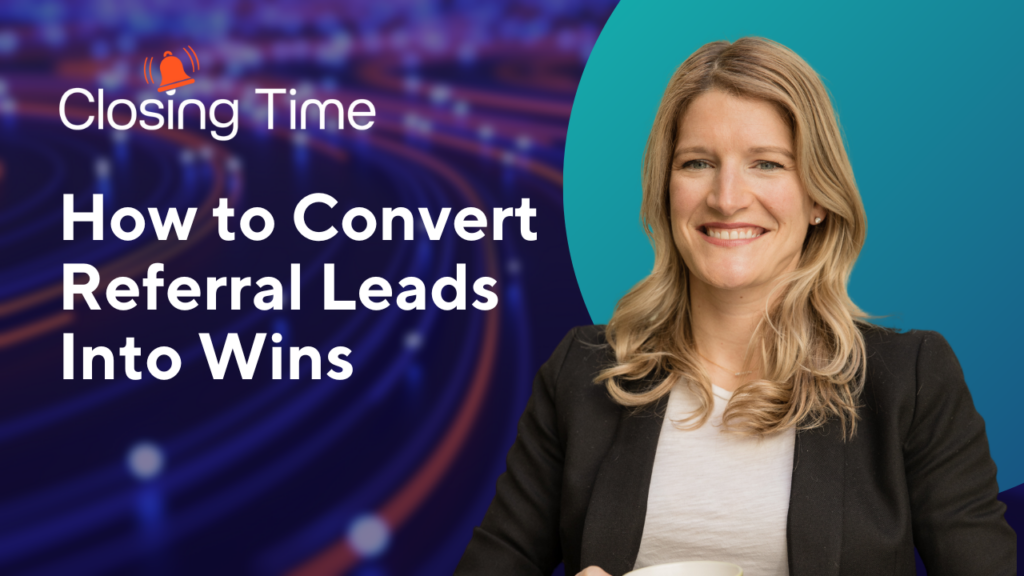Is the sun setting on cold calls?
The data shows that the juice may no longer be worth the squeeze.
Let’s talk about why and what you should do instead on this
special 100th episode of Closing Time.
So exciting.
Hi everyone.
My name is Chip House.
I’m the CMO of Insightly CRM and I’m super excited
to be joined by Sam McKenna for our 100th episode.
Sam is CEO of hashtag. Sam Sales Consulting.
She was an inaugural guest on Closing Time, and it’s so great
to have you back, Sam.. Thanks, Chip. I’m so excited.
And for the hundredth episode, how fun is that?
Isn’t it amazing?
You can see the balloons behind me if they stay in the frame.
Anyway, they’re going to turn around a bit.
So, Sam, as I said, you were one of our earlier guests on the show.
And this is like some two years ago now, which is crazy.
So it just felt right to have you back.
And, you know, we’re going to talk about cold calls, which is kind of been
in the arsenal of the selling, you know, salespeople forever, really.
Right.
And so it’s common to see the number of dials
as a metric that you would measure in sales, etc., etc..
And so let’s talk about why
you think that cold calls may be dead
and what kind of data points at that.
I always want to use this language a little, little trepidatiously,
that cold calls are dead because I sometimes get some hate mail sent
to my house that people love cold calls and think that this is just outrageous.
But here’s my thought.
So I think a couple of things.
In this market today, everybody is saying it is harder and harder and harder
to get executive attention.
How do we cut through the noise?
How do we get them to give us time, etc.?
Why is it that we think that cold calls are going to be the way to do that?
When I think of a cold call,. I think of this.
We are interrupting somebody’s day.
We are calling unannounced.
We are getting them to pick up the phone.
And then we were trying to say, hang on the phone for a couple of seconds.
I really want to tell you about what it is that I can sell you.
And I think if we also look at the data, right, that it takes
an average of 11 cold calls to get somebody to pick up
and then we get an average of 37% as a show rate.
With those meetings that are booked, why would we keep doing that?
Now, We can pull all of this apart from a manager’s perspective
to what’s smarter to do.
But when I think of cold calls,. I just think of them
as really focusing on us as the seller versus thinking about
how to earn the right to the meeting, which I know Kim on our team
at Sam Sales talks about all the time and has talked about on Closing Time.
But I think about how can we do that instead of just smiling and dialing
and only doing cold calls as our main way of booking meetings.
Yeah.
So okay, so we’re not doing cold calls based on that data, Sam.
And I think that’s great, by the way.
So what do you suggest salespeople do instead?
Well, I think, one, we have to change the mindset of the leaders, right?
So when we talk to sales reps, they say, I would never want to cold call
again in my life. I have to do it.
It’s a metric, it’s a KPI, it’s something that I have to do.
So what else am I going to do?
So I think it starts with our leadership, and I’ll say it for a lot of the leaders
we’ve spoken with,
they’ll say This is what we’re doing, we’re still cold calling, etc.
Then let’s say they’ll leave their jobs or let’s say they’re victim to a RIF
or something like that.
And they say, okay, so can we be honest?
And we say always.
And they say, the reason that we still do cold calls is,
I don’t know what else to do.
And the only way for me to keep my job is to do what I know has worked
in the past for us to be able to point to the metrics and say, we’re cold calling
and if we’re not getting deals and we’re not getting pipeline
and we’re not booking meetings, it can’t be us.
We’re doing the right things.
It has to be product market-fit.
It has to be the market, it has to be something else because it’s not us.
And so what. I think we have to think about first
is that the market has shifted, what worked in the 1980s and the nineties
and 2019 doesn’t work anymore today, right?
I feel like sales always go through this reinvention every couple of years.
So we have to think about what does work today and if we don’t know,
we have to be honest to say, listen, we can continue to cold call,
we can continue to look at spray and pray and spam the emails, but
the market has changed.
I don’t quite know what we need to do to be different.
I can help with everything after that, sales acceleration, all that.
But how to get in front of our buyer has changed today and we need to elicit
or solicit an expert to help us figure that out or do your own education.
Listen to events like this, attend webinars and figure that out.
But that’s our starting point.
We have to admit that the way that things happened before
and the way we won before isn’t the way we win today and now, How do we shift?
How do we shift?
Its quality over quantity to me, right?
This is why we talk about show me, you know me, but show me
you know me, the art of doing our research or investing in somebody about trying
to figure out something about them before we reach out.
It’s not a new concept.
This is something I’ve been talking about for over a decade, right?
I got it actually from one of my mentors who always tries to go on record to say,
Hey, I invented show me you know me, Lee Hacohen.
I just went ahead and trademarked it.
But show me or Know me has been around forever.
The tactics that work for us today aren’t really tactics.
They’re the things that we’ve just done all along.
Reaching out and connecting with our buyers
isn’t anything new or any kind of salesy tactic.
It’s just about giving a darn, focusing on who they are, showing up with, something
that actually helps them solve a challenge and doing it in a non salesy, grimy way.
And so when you’re doing Show Me you Know me, Sam, you’re leaning into email,
is that right? Exactly.
Yeah. We start we start with email.
And first think about going a few levels higher in the sales
cycle and outreach than you might or the sales process than you might normally.
So let’s say I maybe traditionally sell to a VP of sales,
maybe instead I’m going to reach out to Dave Osborne at Insightly.
I’m just going to go right to the top and try my very best to get his attention
and book a meeting with him. Why not?
What do you have to lose?
The other thing. I’ll say is the higher you go,
what do we know about their inbox?
We know that an executive’s inbox is filled to the brim with spam emails,
right?
When we think about us doing Show Me. You Know Me, with those individuals,
what an easy way to stand out and really cut through the noise.
The second thing that I would say is just to consider when you go higher
because there’s so much bad volume in their inbox,
we’re going to have a higher chance of getting an open.
But the other thing is
that those executives are exasperated with normal sales tactics.
So just by doing our research and standing out, not only
will we get an open, but will probably get a reply,
even if it’s a no, imagine the conversation that you can spark.
Somebody says,. Great email, I’m not in the market right
now, not the right time.
We already have something like that.
It lets us start a conversation, build a relationship, connect
on LinkedIn, find another time to follow-up, nurture that contact.
The sky’s the limit.
So go high and send ten, 15, 20 emails a week.
Imagine what can happen by investing in that quality.
I’m curious, Sam, because I mean, obviously
a lot has changed, you know, and I’ve been doing this for a while.
So you think back to, you know, the nineties
or whatever and it definitely used to work, right?
But like two main things in my mind were different, People were in offices,
number one.
Yeah, cell phones were not as prevalent and most people
had an office desk and a receptionist.
Right.
What else has changed?
What else do you think is different?
Think about the, one, just selling over email I think was not a thing back then.
But we also didn’t have the power of LinkedIn.
We didn’t have the power of these personal connections
and relationships and referrals and common connections.
We didn’t have all that.
I can’t imagine what it would have been like to sell in that time, right?
Cold calling is exactly probably what I would have done, unfortunately.
But now you have so many better opportunities to do that.
And I think too, with the cold call, right.
Even if we get somebody on to answer the phone, what is it
we’re communicating right.
Again, we’re communicating that we’re interrupting their day.
We have something to sell them to which reps will say back to me,
but I do have something to sell them and it can change their life.
And it’s really beneficial for them.
And if they just hear me out, I know I’m going to make a difference for them.
And I say, Great, find a way to earn that right instead.
Right.
Take advantage of all the things that have changed since the 1990s, right.
The fact that you do have LinkedIn, you have email, you have DMs,
you have the ability to see all these common connections.
You have all this information at your disposal that you can use.
On top of that, our executives are present.
Not even our executives, our senior directors, our directors,
our managers are BDRs are speaking on webinars
they’re speaking, they’re writing articles or posting content on LinkedIn.
They are out there.
It’s never been easier to leverage information
that you can find out about that person in a non creepy and professional way
than it has been today.
Let me give you an example here.
Yeah, If I wanted to get a meeting with somebody by the name of Ryan
who happens to be the CEO of LinkedIn, what am I going to do?
Am I going to send an email?
Am I going to cold call Ryan?
What are the chances. Ryan’s going to ever pick up the phone?
Probably pretty slim to none, right?
If I email him and I kind of use our other tactics
like spray and pray and spammy emails and I say, Quick question, Ryan,
which is, I don’t know,. I have 17 of those emails in my inbox
and you probably do to you, Chip. I do.
But I’m not going to cut through the noise, right?
Instead, why don’t I just do a quick search
of what he’s written so far, or what he said on his podcast that he hosts or
I can pull up the Financial Times article that they did a feature on him,
and it basically gives me an exact roadmap
of how he buys as a CEO.
And under his little picture, it talks about something.
It’s a small pivots in quotes.
It talks about how he loves to make small pivots before he makes big bets.
So I write him an email that says small pivots plus SAM sales,
plus something else that I can find a common connection of ours.
What are the odds of that email’s going to get open?
What would I pay to get a meeting with the CEO of LinkedIn?
And let me tell you, it’s exactly what I did and it’s exactly what worked.
Yeah, I mean,
LinkedIn is proven really, really powerful and we leverage it big time.
And, you know, for those sales reps that are not adopting
Sales Navigator yet, what would you recommend.
Just even popping on their profile, right.
Like Chip, I think if I went on your profile right now I could find,
I don’t know, probably in 3 minutes things about you that I can connect the dots.
If nothing else.
All I have to do is listen to an episode of Closing Time.
Pick up a couple of things that you said.
Look at a few of your posts.
Look at something in your about section.
Right. And pull that together.
You don’t even need Sales. Navigator to do it.
It’s just your basic free subscription to LinkedIn dot com.
It’s all there.
And I think the interesting thing is executives are sometimes making it easy.
I don’t know if you have this on your profile,
but actually a former coworker of Dave. Osborne’s,
a gentleman by the name of Josh Atkins, who is a general manager at Qualtrics.
And if you go and look, Josh used to be a rep on my team years ago.
If you go and look at his profile in is about section, tells you about who he is.
And then at the very bottom
it says if you are a BDR trying to book a meeting with me, here’s how to do that.
If you reference Shakespeare, if you reference my favorite band,
if you talk about this, I’ll open
and respond to your email and I’ll take a meeting with you.
I love that.
Oh my God, it’s that easy.
And you think about, executives are doing that.
They’re saying, I’m going to give you the keys to the kingdom.
If you just figure out, take 2 seconds to do your research, it’s right there.
And how easy you stand out. Right.
And then book the meeting.
I think I even I know
I posted about Josh and about this a few months ago, six months ago,
and nobody used the information to get a meeting.
They still continue to send him, quick question Josh, emails.
Blows my mind.. It really isn’t that hard, I promise.
I think if somebody like commented on my favorite band or drums, you know,
which I’ve been playing for 40 years, you know, I think it would be amazing.
I would definitely respond.
Chip, What is your favorite band?
That’s really hard to say.
You know, I like Rush a lot.
Yeah. Okay.
So what if somebody sent you like the, like the drum emoji
plus a lyric from a Rush song or the Rush name plus hashtag Sam Sales.
How fast would you open that email?
Yeah, right away. Right.
Because it feels like unlike anything else in my inbox.
Right.
And it feels like they know me. So.
Yeah. And it’s you know what?
We get a lot of feedback about this, too, right?
If I make a personal connection with Chip and I talk about
like my favorite Rush song, how I love to play drums, you know,
whatever, if I make that personal connection,
how do I transition that into talking about business?
How am I going to leverage that with Chip?
And the thing is, you’re doing two things.
One, you’re just making a personal connection,
but two, you’re showing someone like Chip, right?
That you were the caliber of person
that gives a darn, that makes an effort, that cares, right?
You’re just different.
You’re not totally in it for yourself.
You’re like, I’m going to make the effort.
I’m going to earn the right to that meeting with you.
And that just signals to Chip, you might be a different kind of sellers.
You might be a different kind of person.. That’s all we want.
We don’t want the same salesy, low bar experience.
We want somebody who’s actually going
to care about us
and care about us as a human too, not just somebody with wallet share.
You can tell when it feels authentic and when it isn’t, you know, and I don’t
know what that line is, but it definitely
you can sense it as a recipient.
I think it’s kind of like the same same thing we do, like on our first date.
You know, if you’re like, Oh, you grew up in Switzerland, that’s cool.
Hey, so what do you want for dinner?
There’s no real authentic connection there, right?
Or somebody that says, I see your son attends university in Richmond,
that’s super cool.
I like Richmond. Hey, do you want to buy our stuff?
No. What about that?
What’s the authentic tie and the connection to it?
And then I think that there’s the prevalent.
I know we’re very off cold calls at this point,
but there’s the very prevalent idea
of personalization at scale too now these days.
Right.
And it pulls in inauthentic pieces.
I think my favorite one that I’ve gotten, we’re a training
company, right, Like, that’s kind of that’s how we’re identified online.
And so somebody sent us an email and said, by the way,
I thought you’d be interested in this, this newsworthy item
that Turkish military jets
were shot down in a training accident.
And we’re like, what in the hell is that about?
Why would we be interested in that?
It’s personalization at scale.
It’s pulling in a snippet about something in the news about training
and completely mismatching with what we do and what we would care about.
That is crazy, yeah. So
just be authentic, Put the time in, right?
No one’s ever going to yell at you for making an effort.
Just give it a shot.
Even if you, instead of cold calling,
take 3 hours to write 20 great emails
and bet your open rate will go through the roof with your funky subject lines.
And I bet on top of that you’ll build a better brand for your company,
for yourself as a rep, and probably give more replies than you ever imagined.
Yeah, so that’s kind of the next step.
Once you figure out how to write these emails, Sam,
then you build like a nursery sequence and then drive that to the same person
and everything is personalized and it kind of progresses.
I assume. Yeah.
And you think about this, too, you’ve done the work for a great subject
line, right?
You’ve, you’ve done that effort already, so you don’t need to do it
every single time you send another email, just reply all, keep the thread going.
Show that person. Hey, this is my 19th email.
Maybe not 19th, but I’ve worked really hard to get to your attention.
Can you please send me a response?
And then you start to think also about timing from that perspective.
You know, and Chip,. I think the recent Harvard Business Review
stat was that executives spend almost 7 hours a weekend working.
Does that align with you?
Just say yes so you look at no matter.
I’m going to say yes. Right.
And what I think is interesting is we can think about instead of ourselves,
think about our buyers, think about their schedules,
think about their inbox, think about when they’re working,
we get a lot of emails that come when, Monday morning.
The last thing I’m doing is responding to a sales email Monday morning.
But when I’m probably going to respond to one, might be if you send it to me
Thursday or Friday
when hopefully
things are a little less hectic and even better if you send the reply
less than 48 hours after the first one and you send it on the Saturday
or Sunday, hit me on a Saturday morning, hit me on a Sunday night.
When I’m prepping for the week ahead,
probably the odds are higher that I’m going to respond to that.
And what we find that they are.
Sometimes you get a 38% response rate just on the weekends alone
because we’re going when they’re working, we know they’re working
and when we don’t have competition.
The same kind of competition we have on a weekday.
That’s a great tip, Sam.
Well, Sam,. I really enjoyed this discussion.
Thank you so much for your thoughts.
Thanks, Chip. Thanks for having me.
Sam, we’re going to have you back again for sure.
And thank you for joining me for this hundredth episode.
And I think I missed it at the beginning.
We’re going to be doing a blooper reel here in a little bit from
all of the different episodes.
We had 60 guests over the past two years, and thanks to everybody that joined us
for any of those episodes, it’s really been our pleasure bringing
go to market content to you and Sam, you are always the chef’s kiss.
Thank you.
Thanks you guys for having me.
And I won’t be disheartened if I know that Amy Volas has more footage
time during those bloopers than I do.. That’s okay.
Yeah,. Well, tell you what. Let’s do a toast.
Cheers, Chip. Cheers.
Should I just drink straight from the bottle at this point?

